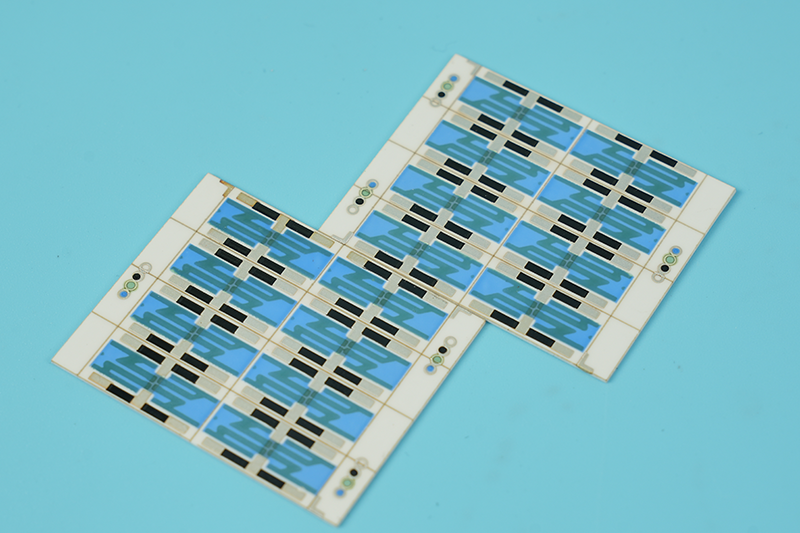Heat dissipation comparison – Ceramic PCB VS Aluminum core PCB
In the world of modern electronics, Printed Circuit Boards (PCBs) form the backbone of various electronic devices, providing the foundation for electrical connections and supporting electronic components. Efficient heat dissipation is a critical consideration in PCB design, as electronic components generate heat during operation. Proper heat management is essential to ensure electronic devices' reliability, performance, and longevity. In this article, we will explore and compare two popular PCB types known for their excellent heat dissipation capabilities: Ceramic PCB and Aluminum Core PCB.

What is Ceramic PCB?
Ceramic PCBs are manufactured using a ceramic material as the substrate. This ceramic material, which may include Aluminum Nitride (AlN), Aluminum Oxide (Al2O3) or Beryllium Oxide (BeO), possesses exceptional thermal conductivity properties. In the construction of Ceramic PCBs, the circuit layer directly interfaces with the ceramic substrate, eliminating the need for an additional dielectric layer. This direct interface allows for efficient and rapid heat dissipation, making Ceramic PCBs ideal for applications requiring high power and intense heat management.

(Structure of Ceramic PCB)
What is Aluminum Core PCB?
Aluminum Core PCBs, also known as Metal Core PCBs (MCPCBs), feature a core layer made of aluminum. Positioned between a copper layer (providing electrical connections and component mounting points) and a dielectric layer (an insulator), the aluminum core acts as a thermal conductor. This design enables effective heat spreading and dissipation, ensuring components stay cool even during demanding operations.

(Structure of Aluminum PCB)
The dielectric layer is the decisive factor affecting the thermal conductivity of an aluminum PCB, generally, its thermal conductivity ranges from 0.8 to 3.0 W/m-K, but can up to 8.0 W/m-K. So, if you are designing a metal core PCB for your electronic device, choosing the right dielectric material can help a lot in the heat dissipation aspect.
Thermal Conductivity: Aluminum PCB vs Ceramic PCB
From above, we know both ceramic circuit board and metal core PCB are good in heat dissipation. To better understand the heat dissipation capabilities of Ceramic PCBs and Aluminum Core PCBs, let's compare their thermal conductivity values:
| Substrate | Thermal Conductivity (W/m*k) | Application | |
| Aluminum | 0.8-3.0 (up to 8.0) | Suitable For High-power Applications | |
| Ceramic Material | A12O3 | 24-28 | Ideal For Ultra-high-power Aapplications |
| AlN | 150-240 | ||
| BeO | 220-250 | ||
How to Choose the Right PCB?
Though both two kinds of PCBs are good in thermal conductivity, how to choose a suitable PCB for your project still needs to be considered in specific applications and various factors. Below are some common considerations for your reference:
a. Power Needs: For power-hungry applications with intense heat generation, Ceramic PCBs with their superior thermal conductivity shine as the obvious choice.
b. Budget Considerations: When keeping costs in check is crucial, Aluminum Core PCBs offer a cost-effective solution without compromising on performance.
c. Application-Specific Demands: Consider the specific requirements of the application, including operating temperatures, voltage levels, and environmental conditions.
d. Design Flexibility: Evaluate whether the design necessitates intricate traces and vias, as Ceramic PCBs can accommodate finer features.
e. Miniaturization: Ceramic PCBs can be manufactured with small size and dimensions, enabling the miniaturization of electronic devices.

Why choose BSTCeramicPCB?
At BSTCeramicPCB, we specialize in providing high-quality PCB manufacturing and assembly services for all around the world customers. With a team of experienced professionals and state-of-the-art facilities, we deliver top-notch Ceramic PCBs, Aluminum Core PCBs, and other advanced PCB solutions such as FR4-PCB, Flex circuits, Metal dome & dome arrays, heavy copper PCBs, ultra-thin PCBs to meet the diverse needs of our clients. Whether it's high-power applications or space-constrained designs, we have the expertise to provide tailored solutions for your PCB requirements. Partner with BSTCeramicPCB for your PCB needs and experience the best in the industry.
Conclusion
Overall, both Ceramic PCBs and Aluminum PCBs offer distinct advantages in terms of heat dissipation capabilities. Ceramic PCBs excel in applications requiring ultra-high power and intense heat dissipation. Their direct heat dissipation through the ceramic material eliminates the need for a separate dielectric layer, contributing to their excellent thermal conductivity.
On the other hand, Aluminum Core PCBs are a cost-effective solution with effective heat-spreading capabilities, making them well-suited for various high-power applications.
When selecting the appropriate PCB for a project, it is crucial to consider the specific requirements. By understanding these factors, engineers can make informed decisions to ensure optimal performance and reliability of their electronic devices. If you are looking for an experienced PCB manufacturer, you can just e-mail us at sales@bstceramicpcb.com.






















































 HOME
HOME







